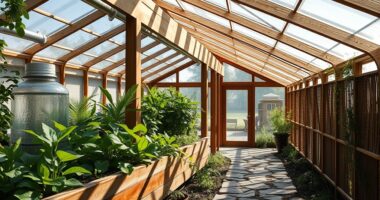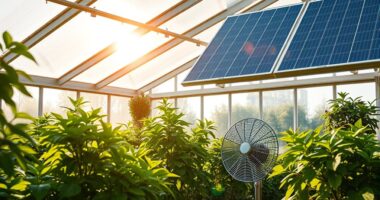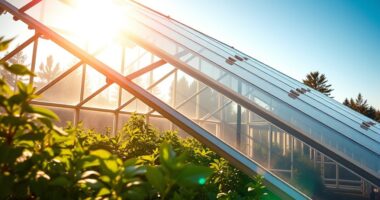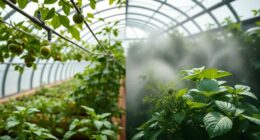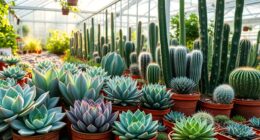Switching to peat-free potting mixes is a sustainable choice for greenhouse growing. These blends replace peat with eco-friendly materials like coconut coir, bark, and composted plant matter, which reduce habitat destruction and lower carbon emissions. They provide healthy nutrients, promote better root growth, and improve water retention without harming the environment. By choosing peat-free options, you support conservation efforts and eco-conscious gardening practices. Continue exploring to learn how to select the best mix for your plants.
Key Takeaways
- Peat-free mixes reduce habitat destruction and carbon emissions, promoting eco-friendly greenhouse gardening.
- They utilize renewable materials like coconut coir, bark, and green compost for sustainable growth media.
- These mixes enhance plant health through natural nutrients, better aeration, and improved water retention.
- Selecting peat-free options supports responsible gardening practices aligned with environmental conservation.
- Implementing sustainable potting mixes helps minimize ecological impact and fosters a greener, more sustainable greenhouse.
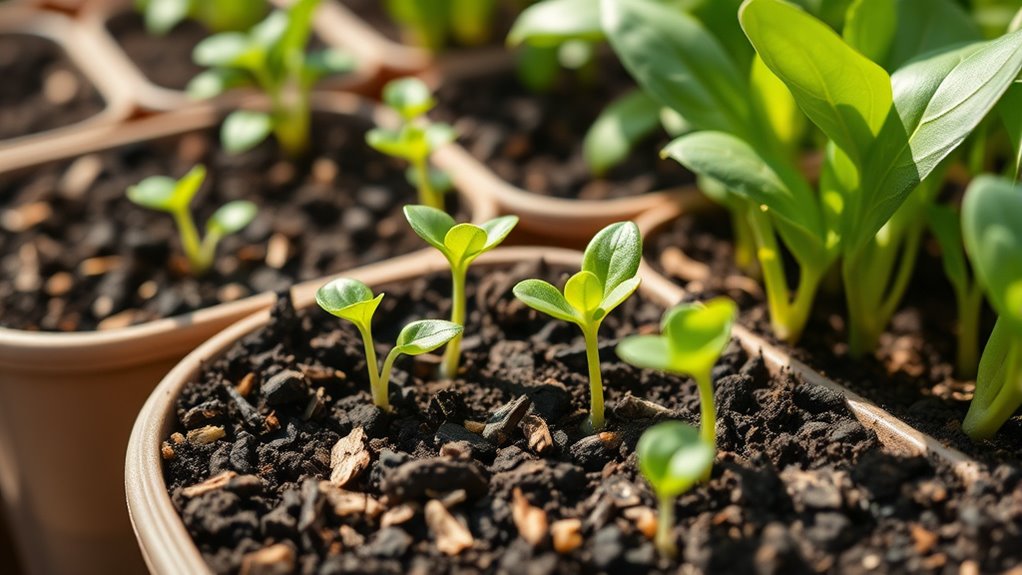
As awareness of environmental impacts grows, many gardeners are turning to peat-free potting mixes as a sustainable alternative. You’re likely aware that traditional peat-based mixes contribute to habitat destruction and carbon emissions, which is why exploring eco-friendly options makes sense. Peat-free mixes often incorporate compost alternatives and organic amendments, offering healthy, nutrient-rich choices for your plants without harming the environment. These mixes not only support sustainability but also promote healthier root development and better water retention, essential for thriving greenhouse plants.
Peat-free mixes promote sustainability with nutrient-rich, eco-friendly compost alternatives and organic amendments for healthier greenhouse plants.
You’ll find that choosing peat-free mixes often involves a combination of compost alternatives such as coconut coir, bark, and green compost, which replace peat’s moisture retention and aeration qualities. These materials are renewable and biodegradable, making them a more responsible choice. Organic amendments, like well-rotted manure or composted plant matter, are frequently added to boost nutrient levels naturally, reducing your reliance on synthetic fertilizers. This approach aligns with organic gardening principles, fostering a balanced ecosystem within your greenhouse.
When selecting a peat-free potting mix, look for products that explicitly highlight their use of compost alternatives and organic amendments. These ingredients guarantee your plants receive essential nutrients while minimizing environmental impact. Coconut coir, for example, offers excellent water retention similar to peat but is harvested sustainably without destroying ecosystems. Bark and wood fiber contribute to aeration and drainage, preventing root rot and encouraging healthy growth. Organic amendments provide a slow release of nutrients, supporting plants over time and reducing the need for frequent fertilization.
Using peat-free mixes can also open the door to experimenting with different compost alternatives and organic amendments, tailoring the mix to your specific plants’ needs. You might mix in additional organic matter for vegetable seedlings or choose a lighter blend for delicate flowering plants. This flexibility helps you maintain a sustainable gardening practice without compromising on plant health. Plus, by opting for these mixes, you’re actively reducing your carbon footprint and supporting the shift toward more eco-friendly gardening supplies. Incorporating best practices in sustainable gardening can further enhance your efforts to grow healthy, thriving plants while protecting the environment.
Frequently Asked Questions
Are Peat-Free Mixes as Nutrient-Rich as Traditional Mixes?
Peat-free mixes can be just as nutrient-rich as traditional ones if you choose the right ingredients. They often feature compost, coco coir, or other organic materials that enhance nutrient retention, ensuring your plants get what they need. Plus, these mixes improve soil structure, promoting healthy root development and better water drainage. With proper formulation, peat-free options support vibrant growth without sacrificing nutrient content or soil health.
How Do Peat-Free Mixes Affect Plant Growth Rates?
You might worry that peat-free mixes slow plant growth, but they actually support healthy development by enhancing soil aeration and moisture retention. These mixes create a better environment for roots, enabling faster nutrient uptake and vigorous growth. With improved oxygen flow and consistent moisture, your plants thrive just as well, if not better, than in traditional mixes. So, switching to peat-free options can boost your greenhouse’s overall plant performance.
Can Peat-Free Mixes Be Used for All Plant Types?
Yes, you can use peat-free mixes for most plant types, but it’s important to take into account plant variety suitability and container compatibility. Some plants, like orchids or cacti, may need specialized mixes that provide excellent drainage or specific nutrients. For general greenhouse plants, peat-free mixes usually work well, but always check the individual plant’s growing requirements to guarantee optimal growth and health.
What Are the Long-Term Environmental Impacts of Peat-Free Mixes?
Using peat-free mixes decreases your carbon footprint and supports biodiversity preservation. Over time, these mixes help prevent habitat destruction caused by peat extraction, which harms wildlife and releases stored carbon. By choosing sustainable options, you actively contribute to environmental health. Long-term, peat-free mixes promote healthier ecosystems, reduce greenhouse gases, and ensure that natural habitats are preserved for future generations, making your greenhouse practices more eco-friendly and sustainable.
Are Peat-Free Potting Mixes More Cost-Effective Than Traditional Options?
Peat-free potting mixes can be more cost-effective over time, even if the initial investment is slightly higher. You might pay more upfront for quality peat-free options, but their durability and improved plant health often reduce the need for frequent replacements or additional fertilizers. When doing a cost comparison, consider long-term savings on resources and plant success, making peat-free mixes a smart, environmentally friendly choice that pays off in the end.
Conclusion
By choosing peat-free potting mixes, you’re subtly nurturing a more sustainable future for your greenhouse. While these options may require a gentle learning curve, they offer a harmonious balance between growth and stewardship. Embrace the shift, and you’ll find yourself cultivating not just plants, but a deeper connection to the environment. In doing so, you help guarantee that vibrant green spaces continue to flourish quietly, echoing a quieter, kinder way to nurture life.


